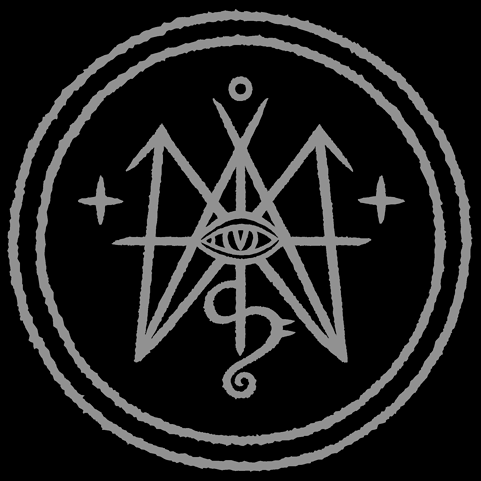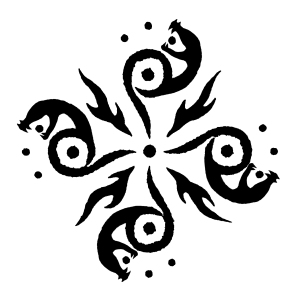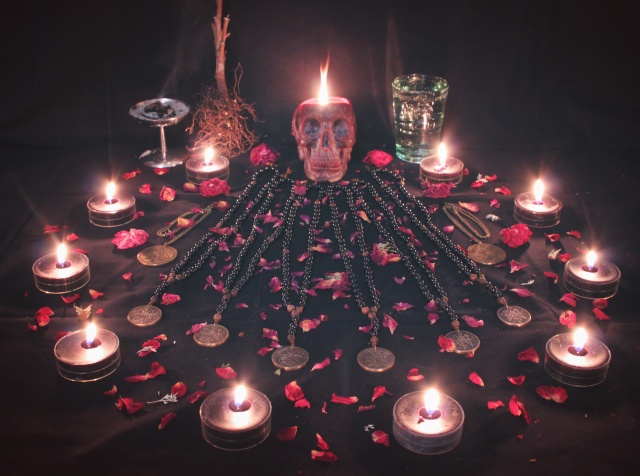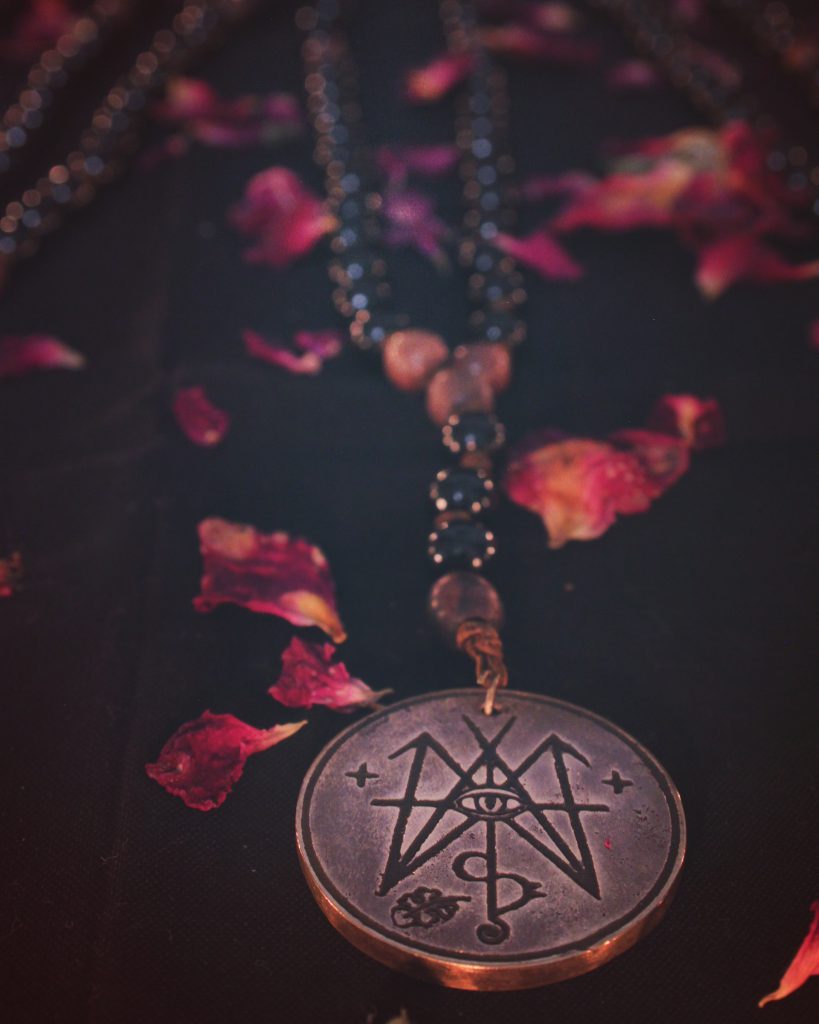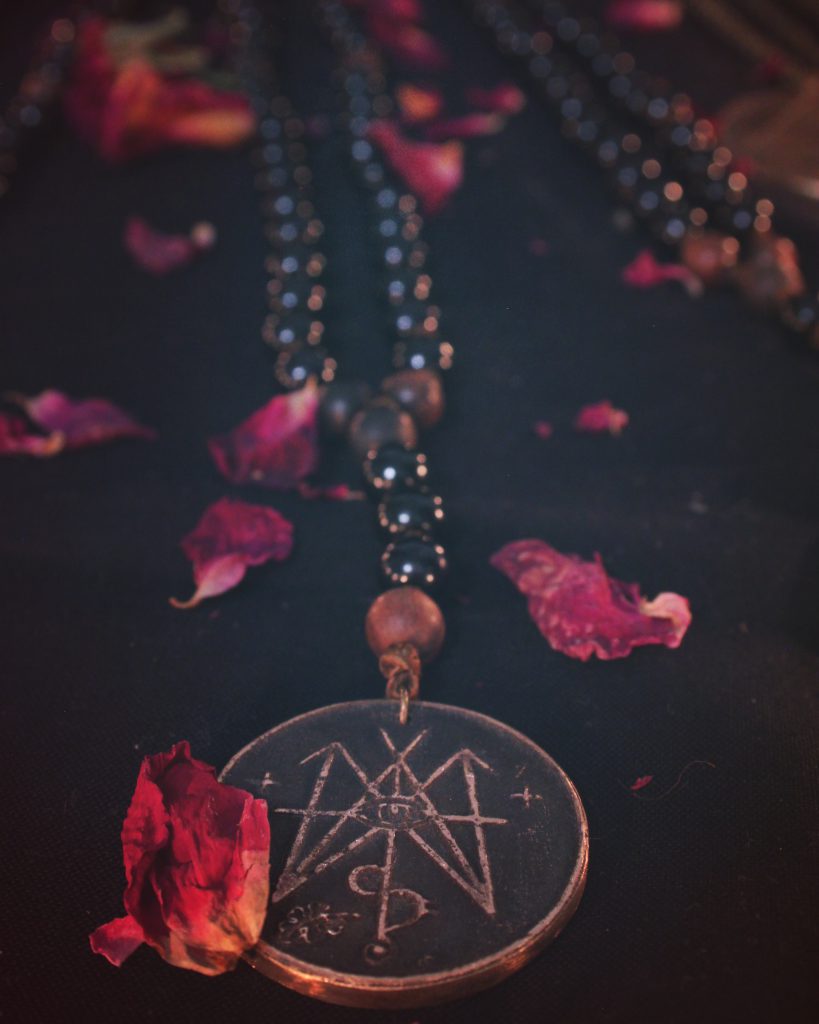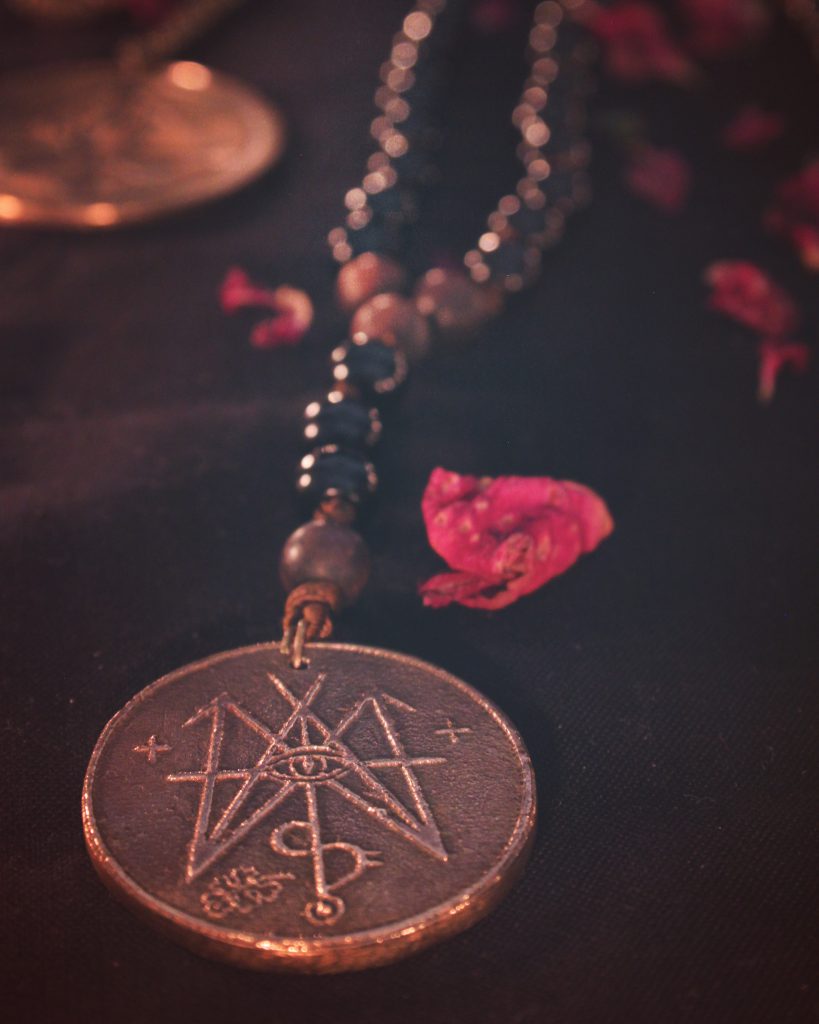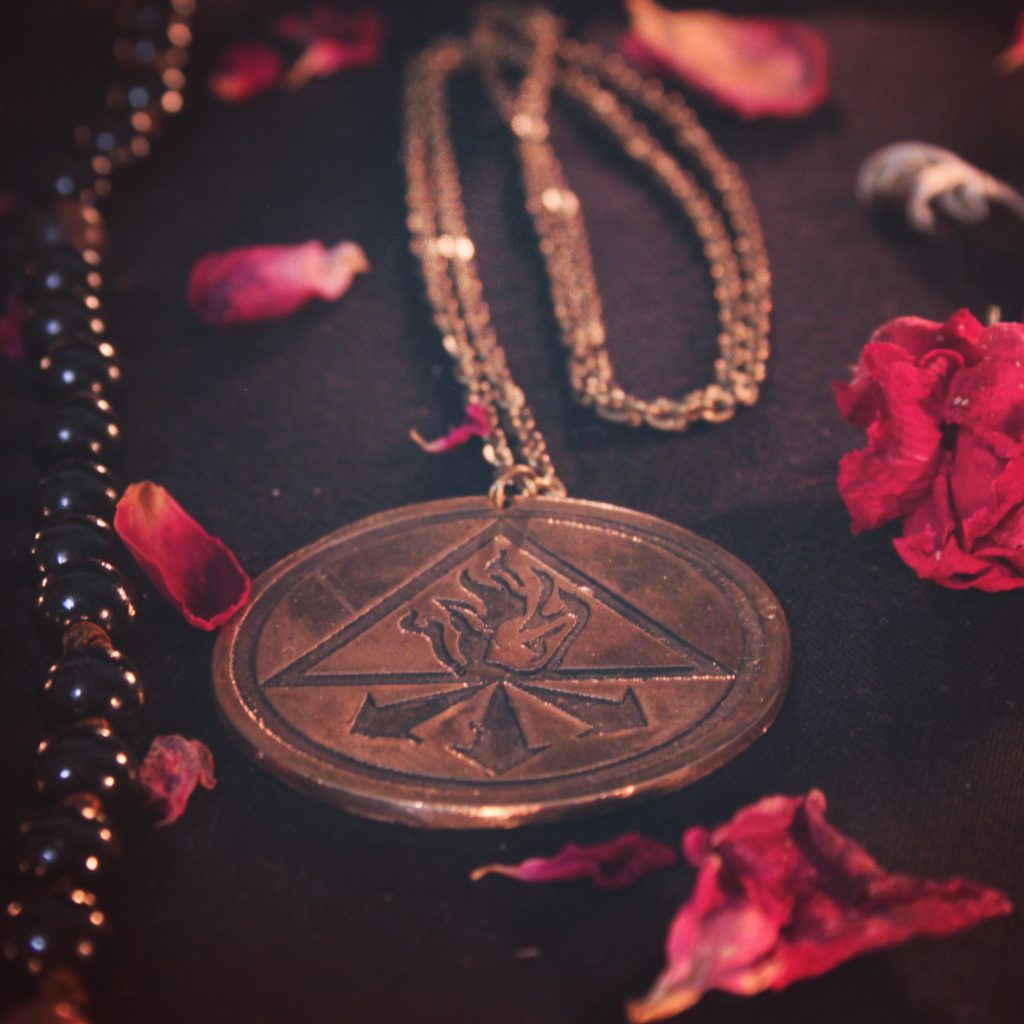I have shared this with a few customers, so I make it available here as well. This is a short research into the plants that compose my incense blend for contemplative work with the qlipha Thagirion.
Aspects that tie in here are the sun of the underworld and afterlife, the sun’s burning and eruptive aspects, fire of inspiration etc. Here are also references to the ecstasy of the lotophagi. What may need further investigation is the concept of the sin eater, which is addressed in the title illustration, but not discussed in this text.
Keywords: cleansing, renewal, leaving behind the shadow of death, ecstasy, fire of inspiration, arts, collective efforts, destruction/ change of ego-patterns
Scent: deep, warm, sweet

1. Blue Egyptian Water Lily (Nymphaea caerulea) has been used ritually for millennia. The lotus is a symbol of divinity and beauty. In Egypt it rose and faded with the sun and was sacred to the sun gods. An entire cosmogony (rule by the ogdoad) was based on the lotus. The flower features prominently in religious art all over the world and bears associations both with creation myths as well as the afterlife. Both the blue and white water lily contain alkaloids, which act euphoric, narcotic and anti-spasmodic. Extracts of water lily have been used as a substitute for opium during WWI. The lotophagi in Homer’s account of the Odyssey may have consumed this plant. It is said to induce a state of bliss and indolence. In Egyptian art it is depicted in connection with dancing or in key rites such as the rite of passage into the afterlife. Whereas the white lotus would appear on the drinking vessels of the living the blue lotus was reserved for sacred ceremonial ritual vessels. Because of its links to the sun of the underworld, sleep and intoxication I found the blue lotus useful in ritual work with the qlipha Thagirion.

2. Calamus root (Acorus Calamus), or sweet flag as it is often called, is associated with the sun and the male. The root oil is aromatic and part of perfumes, liquors and also cola. The root extract has stimulant, warming (sun) and aphrodisiacal properties. It is a traditional ingredient in ketoret temple incense and may aid in establishing contact with one’s guardian ‘angel’. Calamus can act as a mood elevator and cause mild hallucinations. So here we have another plant that grows in or close to water. The name calamus comes from Greek κάλαμος (kálamos), meaning “reed”, “straw” or “pipe”. The shaft has been used for making writing instruments as well as pipes. Calamari are named after the plant. The Latin name acorus in turn may be derived from Greek άχόρου (áchórou) and κόρη (kóri), referring to the pupil of the eye. The root extract was apparently also a remedy for eye diseases, which cause a ‘darkening of the pupil’. The bittersweet and slightly nauseating scent of calamus root has grown on me. When adding it to any herbal blend I feel it gives it a boost (strengthening) and also adds protective qualities. In addition I found it potent in dream work. I also added it to self-made herbal liquors and it left me with a bit of a headache. Use with care.

3. Wild dagga (Leonotis leonurus) is also known by the name lion’s tail. It was brought to my attention by a good friend. The orange flowers and its name are of course evocative of the sun. The herb is endemic to the Southern Africans and used in traditional African medicine. Its energizing effects have been compared to energy drinks, whilst others say it acts similar to Cannabis when smoked. It is said to induce euphoria and mild hallucinations. In smoking recipes it is combined with water lily to enhance these effects. The species Leonorus nepetifolia is said to act significantly stronger than its relative. Leonorus is used in traditional medicine to cure fevers, snake bites, scorpion stings and other inflammations. So this sunny herb counteracts many physical ailments that deal with too much heat – Mars influences, but also the effects of venturing too close to the sun (burns). Leonotis means “lion’s ear” and is a reference to the shape of the flower crown. I found it a nice signature reference to Sorath, the black lion prince of Thagirion.
 4. Hibiscus (Hibiscus spcc.) is another plant associated with the sun. But the red hibiscus flower is also sacred to the Hindu goddess Kali, who is sometimes depicted merging with the flower in form. Hibiscus tea is rich in Vitamine C and minerals, strengthens the immune system and is as such used as a mild medicine during the winter time. It is also pleasant to drink cold during hot summer days. Hibiscus lowers blood pressure. Interestingly, extracts from the flowers of Hibiscus rosa-sinensis have shown to function as an anti-solar agent by absorbing ultraviolet radiation. So here is another ‘sun’ herb that counteracts characteristics of its planetary influence. Hibiscus is the national flower of Malaysia, also called Bunga Raya, “grand flower”, representing life and courage. In China it is also called zhū jǐn, “vermilion hibiscus” and is identified with wealth and fame. Otherwise it stands also for the attractiveness of a young female virgin. In South-Korea hibiscus symbolizes immortality. In the Victorian language of flowers Hibiscus translates as “delicate beauty”. The hibiscus flower tea that is sold in Europe is mostly composed of the calyxes from the species Hibiscus sabdariffa, also known as Roselle and the tea is called Karkadeh. I keep searching for the red Chinese hibiscus, though I feel in shape and essence the flowers of H. sabdariffa are also suitable. I find particularly interesting the association with Kali, as an embodiment of adversarial beauty, black, fierce and destructive, destroyer of illusions, demanding bloody sacrifice, yet also bestowing boons to the faithful – favoring the beautiful hisbiscus flower amongst her offerings.
4. Hibiscus (Hibiscus spcc.) is another plant associated with the sun. But the red hibiscus flower is also sacred to the Hindu goddess Kali, who is sometimes depicted merging with the flower in form. Hibiscus tea is rich in Vitamine C and minerals, strengthens the immune system and is as such used as a mild medicine during the winter time. It is also pleasant to drink cold during hot summer days. Hibiscus lowers blood pressure. Interestingly, extracts from the flowers of Hibiscus rosa-sinensis have shown to function as an anti-solar agent by absorbing ultraviolet radiation. So here is another ‘sun’ herb that counteracts characteristics of its planetary influence. Hibiscus is the national flower of Malaysia, also called Bunga Raya, “grand flower”, representing life and courage. In China it is also called zhū jǐn, “vermilion hibiscus” and is identified with wealth and fame. Otherwise it stands also for the attractiveness of a young female virgin. In South-Korea hibiscus symbolizes immortality. In the Victorian language of flowers Hibiscus translates as “delicate beauty”. The hibiscus flower tea that is sold in Europe is mostly composed of the calyxes from the species Hibiscus sabdariffa, also known as Roselle and the tea is called Karkadeh. I keep searching for the red Chinese hibiscus, though I feel in shape and essence the flowers of H. sabdariffa are also suitable. I find particularly interesting the association with Kali, as an embodiment of adversarial beauty, black, fierce and destructive, destroyer of illusions, demanding bloody sacrifice, yet also bestowing boons to the faithful – favoring the beautiful hisbiscus flower amongst her offerings.
Now we have three different flowers, all powerful and representative of the sun, and we have also looked at inherent adverse or inverse aspects of that planetary influence. In color we range from blue to green to orange to a deep red. To complete the visible spectrum we are yet missing a yellow herb. One that immediately comes to mind is the sunflower, perhaps the boldest representative amongst all ‘sun’ herbs. (Could have started with this one, right?)

5. The indigenous peoples of America viewed the sunflower (Helianthus annuus) as a symbol of their solar deities, which represented life and sustenance. Early Spanish explorers imported the sunflower to Europe. Consequently sunflower became one of the most important agricultural commodities. Sunflower, particularly seed, is rich in nutrients and has a wide range of medicinal properties. It is also a flower chosen by some spiritual movements as a motto and symbol for ‘turning to the light of truth’, based on the sunflower’s alleged heliotropism. True is, the flower buds and leaves turn indeed towards the light and then usually point towards the noon sun, and act thus as a compass. But the stem of a mature flower freezes and remains in its position, usually pointing East. The size of a sunflower does btw. depend directly on the amount of light it receives, meaning the sunnier the bigger.

The second misconception refers to the “flower” of the sunflower, which is actually a “flower head” or pseudanthium of numerous small individual five-petaled flowers, so-called “florets”. The florets can be of varying color, from yellow to green to a dark brown. Ever fascinating is the spiral arrangement of the florets. Each floret is oriented toward the next by approximately the golden angle, 137.5°, producing a pattern of interconnecting spirals, where the number of left spirals and the number of right spirals are successive Fibonacci numbers. Typically, there are 34 spirals in one direction and 55 in the other; however, in a very large sunflower head there could be 89 in one direction and 144 in the other. This pattern produces the most efficient packing of seeds mathematically possible within the flower head. Natural growth patterns are an aspect I have also come to relate with this qlipha and may have subconsciously inspired the title graphic, which builds upon my old sun symbol, employed here in a repetitive pattern to form a more complex structure.
The way, in which the sunflower florets are packed close together does remind me of honeycombs, as if the flower was a mirror to the structures built by bees. Also how bees live in a swarm collective and function together as a single organism, is similar to how the flower head of the sunflower is comprised of myriads of little, neatly organized florets. The florets are surrounded by so-called “ray flowers”, which resemble petals. They help attract pollinators such as bees. We see how the single flowers are organized, each serving its purpose. The individual or the small piece is part of a higher order or collective, which achieves more than the individual alone.
A not so friendly feature are the sunflower’s allelopathic properties: sunflowers emit substances that hinder other plants from growing in their proximity. The sunflower has means to defend itself. This feature would translate also spiritually as a way of self-defense. But more along the line: I grow and prosper here, you may not. Or: for the sun to shine on me, others have to remain in my shadow. This is of course putting it a bit drastic. The sunflower’s biochemical self-defense mechanism reaches only so far, just enough to ensure it can grow and unfold. In my view, this pierces deeply though into that Thagirion complex, where we are confronted with the excesses of ego-worship. It is essentially about balancing ego extremes and finding a way, away from the superficial compensation of inferiority complexes to profound and long lasting changes.
Now on to a herb that is actually more considered a Saturn herb, but which also has some interesting indirect links to the sun. The herb experienced a revival during the hippy era and was consumed together with blue water lily and wild dagga:

6. The wild lettuce (Lactuca virosa) sports golden-yellow flowers and spinose green foliage. It goes also by the names bitter lettuce and opium lettuce. Ingesting the plant is said to bring about psychotropic, calming and anodyne effects similar to opium and it is sometimes combined with Nymphea caerulea for that purpose. In herbal medicine it is mainly used as a mild painkiller and for treating nervousness. Whilst heroine and other opiates may initially cause nausea and vomiting, wild lettuce is said to not have such side effects. Either the dried herb or latex extracted from the stem are smoked or added to tea or soaked in alcohol. The dried latex (a milky white sap) is also called Lactucarium and has also been consumed directly. Beside lactucine, the plant is also said to contain the tropane alkaloid hyoscyamine, which is found in most nightshades, such as henbane (Hyoscyamus niger).
The plant is a wild forebear of the garden lettuce, which is widely used in salads. Hildegard von Bingen noted about the herb:
“The lettuces, which can be eaten, are very cold, and when eaten without spice they make the brain of man empty with their useless juice. …But the wild lettuces have almost the same nature. For anyone who would eat lettuces, which are useless and are called weeds, either raw or cooked, would become mad, that is insane, and he will become empty in the core”
Obviously a rather negative review of the herb and its qualities, however the mind altering and emptying attributes fit for the work with this qlipha. In the 16th century, Gerard said of wild lettuce:
“it procures sleep, assuages paine, moves the courses in women, and is drunke against the stingings of scorpions and bitings of spiders. The seed taken in drinke, like as the garden lettuce, hindreth generation of seed and venereous imaginations.”
In other words it kills (or at least decreases) sexual drive. Victorians feared the herb would induce childlessness.
Ironically wild lettuce was sacred to the Egyptian god Min, a fertility deity, god of male sexual potency, crops and also of magical plants. Min was believed to ensure the annual flow of the river Nile and fertility of the land people of Egypt. His depictions are ithyphallic, showing the deity with a large erect penis and lettuce beside him. He was also envisioned to lay on a bed made entirely of lettuce. Wild lettuce was considered an aphrodisiac in ancient Egypt. The milky latex exuded from the stems may have been thought of as resembling semen and the plant’s vertical growth was considered phallic. Oddly, depictions of Min show him as missing one arm and strangely two-dimensional. When still human Min was put in charge to guard and care for the women left behind when the other men went to war, possibly facing defeat and death. But they returned successful. Only to find all their women pregnant. Enraged, they cut Min in two halves. Min was also a god of the desert, lightning and sandstorms. Again we are confronted with ambiguous properties, aphrodisiac and anaphrodisiac at the same time, evocative of male potency, abundance, fertility and prosperity, but also opposite visions of castration, childlessness, destruction and sacrifice (ego death). In ancient Greek manuscripts the plant is btw. referred to as ‘Titan’s Blood’, relating it to the giant gods that battled the Olympians, which links the herb with the adversary of gods and men alike.
Adding wild lettuce means breaking with typical sun herb patterns and euphemistic sun attributes and instead shifting focus further towards other aspects. Wild lettuce also enhances the mind altering qualities of some of the herbs contained herein.
7./8. As for the resins to round up this blend I used storax-soaked charcoal, which adds a sweet warm scent, and Olibanum from Aden, which has a fresh, citrus-like aroma and is overall stimulant. Keeping it simple here.
The above herbs and flowers come from different cultures and regions. When burnt, all of these ingredients will turn black and be reduced to ashes whilst releasing their essence. The ashes may be collected and used in further rituals, e.g. for protection and cleansing.

Update: The first batch is sold out. The second batch will be available February 17th, 2017.
For ordering write to info@teufelskunst.com
January 19, 2017
Posted In: Herbs & Seeds, Incense
Tags: dream-inducing, calamus, oneirogenic, ego death, qliphoth, hibiscus, qliphotic, sorath, entheogen, spiritual properties, hallucinatory, sunflower, herbs, psycho-active, wild dagga, dream work, pychotropic, wild lettuce, oneiric, thagirion, kliffot, visions, blue lotus
